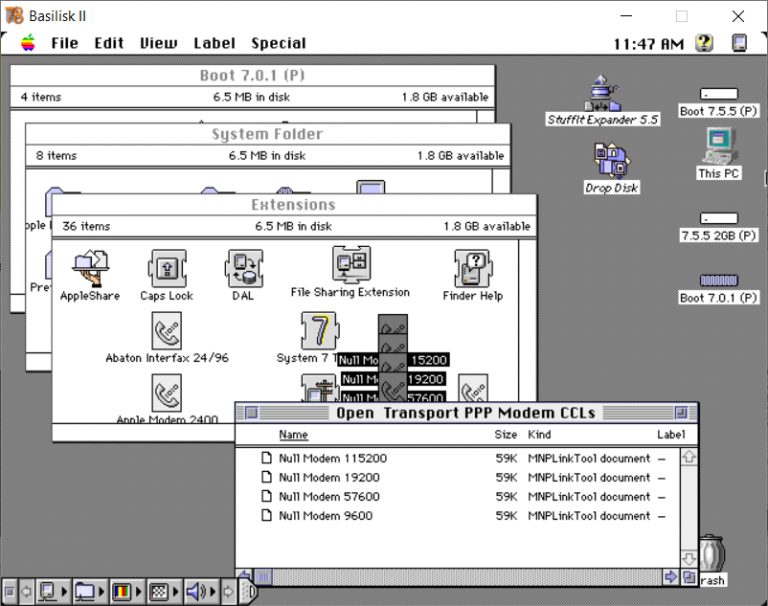

Basilisk ii setup code#
(the code and this documentation come from QEMU)īy setting the "ethernet card description" to "slirp",īasilisk II uses a completely user mode network stack (youĭon't need root priviledges to use the virtual network).

Access the network through the user mode network stack. in a KDE environment, kdesu can be used as follows:Įxec /usr/bin/kdesu -c /path/to/tunconfig $1 $2Ĥ. Invokes your favorite program to enhance a user priviledges.Į.g. Otherwise, you can still write a helper script which So that "/sbin/ifconfig" and "/sbin/iptables" can be executedĪs root. This script requires you that "sudo" is properly configured # echo 1 >/proc/sys/net/ipv4/ip_forwardĪ virtual network configuration script is required and theĭefault is /usr/local/BasiliskII/tunconfig unless you specifyĪ different file with the "etherconfig" item. Make sure IP Fordwarding is enabled on your system Make sure the "tun" kernel module is loaded Instead of sending packets via physical media writes them to Physical media, receives them from user space program and Or Ethernet device, which instead of receiving packets from a It can be viewed as a simple Point-to-Point TUN/TAP provides packet reception and transmission for user The "ethernet card description" must be set to "tun". Access the network through a "tuntap" interface. (instead of the ones given in the example above).ģ. Your network administrator about the nets and zones you can use If you are in an existing AppleTalk network, you should contact MacOS should automatically recognize the nets and zones upon startup.

"Ethernet" (net 1) for the Ethernet and a zone "Basilisknet" (net 2)įor the internal network connection of the ethertap interface. Tap0 -seed -phase 2 -net 2 -addr 2.47 -zone "Basilisknet" Here isĪn example /etc/atalk/nf for a LAN:Įth0 -seed -phase 2 -net 1 -addr 1.47 -zone "Ethernet"
Basilisk ii setup install#
Install and configure netatalk if you want to use AppleTalk. The drawback is that youĬan only use network protocols that Linux can route, so you have to That your Linux box has access to (especially, if your Linux box hasĪ dial-up Internet connection and is configured for IP masquerading, This approach will let you access all networks Virtual network and set the default gateway to the IP address of theĮthertap interface. Under MacOS, select an IP address that is on the
Basilisk ii setup how to#
Information on how to set up /dev/tap* device nodes and activate theĮthertap interface. Next, see /usr/src/linux/Documentation/networking/ethertap.txt for comment out the line "dev->flags|=IFF_NOARP " in ethertap_probe() insert "#define CONFIG_ETHERTAP_MC 1" near the top (after the You also have to modify drivers/net/ethertap.c "Netlink device emulation", under "Network device support", activate Under "Networking options", enable "Kernel/User netlink socket" and It also requires that youĬonfigure your kernel to enable routing and ethertap support: In this case, the "ethernet card description" must be the name Putting Basilisk II on a virtual Ethernet via the "ethertap" device. Networks that your Linux box routes (e.g. MacOS will only beĪble to talk to other machines on the Ethernet, but not to other Under MacOS (TCP/IP, AppleTalk, IPX etc.) but there is no connectionīetween Linux networking and MacOS networking. The sheep_net module will allow you to run all networking protocols To "/etc/nf", the kernel should be able to load the moduleĪutomatically when Basilisk II is started.
If you copy the sheep_net.o module to a place where it can be foundīy the kernel module loader ("/lib/modules/To compile and install the module yourself: The sheep_net module is included in the Basilisk II sourceĭistribution in the directory "src/Unix/Linux/NetDriver". The "ethernet card description" must be the name of a real Ethernet

Direct access to an Ethernet card via the "sheep_net" kernel module.


 0 kommentar(er)
0 kommentar(er)
